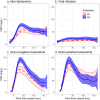Characterizing CRP dynamics during acute infections
- PMID: 39467995
- PMCID: PMC12137512
- DOI: 10.1007/s15010-024-02422-7
Characterizing CRP dynamics during acute infections
Abstract
Purpose: C-reactive protein (CRP) is a common proxy of inflammation, but accurate characterizations of its dynamics during acute infections are scant. The goal of this study was to examine C-reactive protein (CRP) trajectories in hospitalized patients with viral infections, confirmed bacteremia (stratified by Gram-negative or Gram-positive bacteria), and non-bacteremic infections/inflammations, considering antibiotic treatment.
Methods: Electronic medical records from Tel Aviv Sourasky Medical Center (July 2007-May 2023) were analyzed. Patients with blood cultures or positive viral tests were included. CRP levels were modeled using generalized additive mixed-effects models (GAMMs) and observed up to 150 h after initial infection diagnosis. Patients with initial CRP levels > 31.9 were excluded, to remove individuals already in a highly active inflammatory process. The shapes of the CRP curves were characterized and peak CRP as well as area under the CRP curve were the primary variables of interest.
Results: Viral infections had the lowest and flattest CRP curves. Non-bacteremic infections showed intermediate levels, while bacteremia (especially Gram-negative under antibiotic treatment) had the highest CRP peaks. For instance, peak CRP ranged from 15.4 mg/L in viral infections without antibiotics to 140.9 mg/L in Gram-negative bacteremia with antibiotics.
Conclusions: CRP trajectories significantly differ based on infection type and antibiotic treatment. Frequent CRP measurement could be a valuable diagnostic and risk stratification tool in hospitalized patients.
Keywords: Antibiotics; Bacteremia; CRP dynamics; CRP trajectories; Infection.
© 2024. The Author(s).
Conflict of interest statement
Declarations. Ethical approval: The study was approved by the Institutional Review Board (Helsinki) Committee of Tel Aviv Sourasky Medical Center. Consent to participate: Since this was a retrospective study, using archived medical records, an exemption from informed consent to participate was granted by the Helsinki Committee. Consent to publish: Since this was a retrospective study, using archived medical records, an exemption from consent to publish was granted by the Helsinki Committee. Competing interests: The authors declare no competing interests.
Figures

References
-
- Sasaki K, Fujita I, Hamasaki Y, et al. Differentiating between bacterial and viral infection by measuring both C-reactive protein and 2′-5′-oligoadenylate synthetase as inflammatory markers. J Infect Chemother. 2002;8:76–80. - PubMed
-
- von Dach E, Albrich WC, Brunel A-S, et al. Effect of C-Reactive protein–guided antibiotic treatment duration, 7-Day treatment, or 14-Day treatment on 30-Day clinical failure rate in patients with uncomplicated gram-negative bacteremia: a Randomized Clinical Trial. JAMA. 2020;323:2160–9. - PMC - PubMed
MeSH terms
Substances
LinkOut - more resources
Full Text Sources
Medical
Research Materials
Miscellaneous

